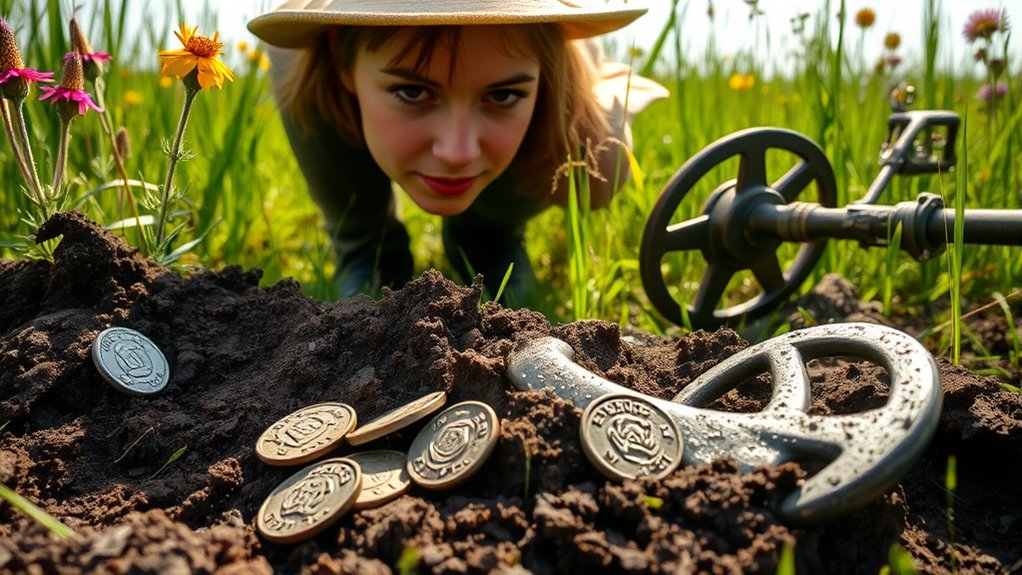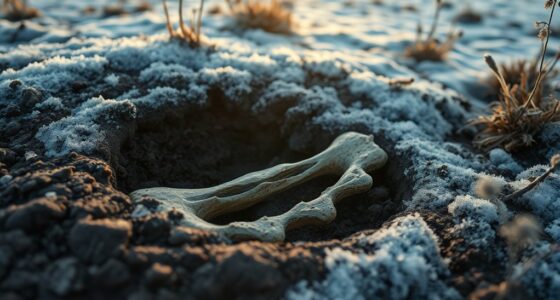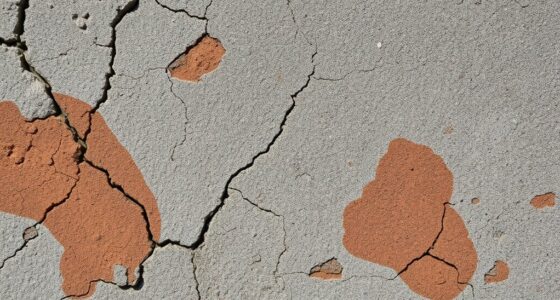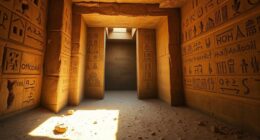If you’re interested in the discovery, an amateur treasure hunter recently uncovered a medieval coin hoard in a remote English field. The buried coins, preserved by natural soil conditions, offer a rare glimpse into medieval craftsmanship, trade, and metallurgy. Some coins are well-preserved, showing detailed inscriptions, while others are worn from rough techniques. Keep exploring to find out how this find reshapes our understanding of local history and ancient coinage.
Key Takeaways
- An amateur treasure hunter uncovered a hidden cache of medieval coins during field exploration in England.
- The coins, buried for centuries, were well-preserved due to favorable soil conditions.
- Analysis of the coins reveals details about medieval metallurgy, minting techniques, and trade routes.
- The find provides valuable insights into local history and medieval economic practices.
- Proper archaeological methods helped preserve the coins’ details for future research and historical understanding.
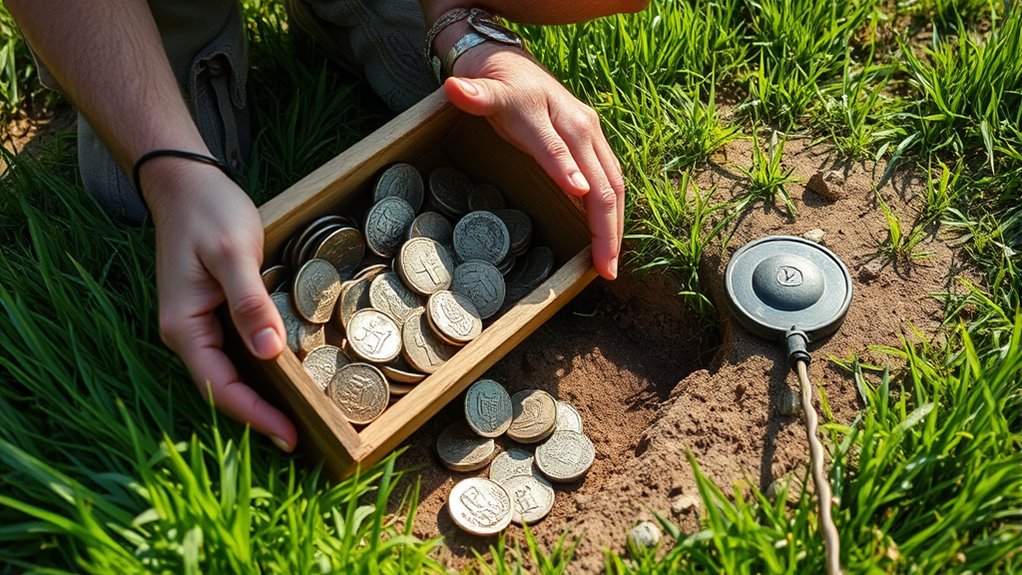
While exploring a remote field, a dedicated treasure hunter uncovered a hidden cache of medieval coins, shedding new light on local history. The discovery instantly captured attention, revealing a collection that had been buried for centuries and is now offering a rare glimpse into medieval metallurgy. As you carefully excavate the coins, you realize that their preservation has played a fundamental role in maintaining their historical value. Thanks to the natural conditions of the soil, many of the coins remain remarkably intact, allowing you to analyze their inscriptions, mint marks, and metal composition with clarity.
Medieval metallurgy techniques influenced the quality and durability of these coins. You notice the varying shades of the metal—some coins retain a silvery sheen, while others show signs of oxidation and corrosion. This diversity speaks to the different methods used during their minting, as well as the natural aging process. Your understanding of coin preservation becomes indispensable here; the way these coins were buried has helped slow down deterioration, enabling you to study their features more closely. This preservation not only maintains their physical integrity but also offers insights into the economic and material culture of the time.
Medieval coin preservation reveals insights into minting techniques and economic history.
Handling these coins, you realize that the craftsmanship involved in medieval metallurgy directly impacted their longevity. You observe that some coins were struck with a high degree of skill, with clear images and inscriptions, while others are more worn, revealing the rougher, less refined techniques that might have been used during periods of metal scarcity or political upheaval. The preservation of these details is essential for historians and collectors alike, as it helps reconstruct the historical context in which they were created. This metallurgy knowledge enhances our understanding of the technological advancements of the period and their influence on coinage. Additionally, studying the metal composition of the coins can provide clues about trade and resource availability during the era.
Your discovery emphasizes how indispensable coin preservation is for understanding medieval societies. Without the natural and deliberate efforts to protect these objects over centuries, much of their detail and historical significance could have been lost. This highlights the importance of proper artifact preservation techniques in archaeological excavations, which can greatly impact the longevity of such discoveries. The natural environment and soil chemistry have played a crucial role in the preservation process, helping to maintain the coins’ condition over time. As you document your find, you realize that this hoard could reshape local history narratives, illustrating trade routes, economic stability, and resource management during the medieval period. This find isn’t just about the monetary value but about unlocking stories long buried beneath the earth.
In addition, studying these coins provides valuable insights into archaeological methods, which are essential for uncovering and preserving ancient artifacts effectively. In the end, your meticulous work and respect for the coins’ delicate state guarantee that future scholars can continue to study and learn from this treasure. The combination of medieval metallurgy and effective coin preservation has granted you a rare opportunity to connect with history firsthand, making this discovery a truly remarkable chapter in your treasure-hunting journey.
Frequently Asked Questions
What Tools Did the Treasure Hunter Use to Locate the Hoard?
You likely used a metal detector to locate the hoard, scanning the ground for hidden metallic objects. Ground scanning technology, like ground-penetrating radar, may have helped you identify potential dig sites beneath the surface. These tools allow you to pinpoint promising areas without excessive digging, increasing your chances of discovering valuable artifacts like medieval coins. Combining both tools makes your search more efficient and successful.
How Old Are the Coins Approximately?
Think of these coins as whispers from the past, echoing centuries of history. Using coin dating techniques, you can estimate their age, which likely falls between the 12th and 15th centuries. These medieval currency pieces reveal a window into medieval life, trade, and economy. Though exact dating requires expert analysis, you’re holding treasures that are approximately 600 to 900 years old, connecting you directly to medieval history.
Were There Any Valuable Non-Coin Artifacts Found?
You’ll be glad to hear that no valuable non-coin artifacts were found during the discovery. The treasure hunter mainly uncovered medieval jewelry and some ancient pottery alongside the coin hoard. These items offer a fascinating glimpse into the period’s craftsmanship and daily life. While there’s no mention of other artifacts, the jewelry and pottery alone considerably enrich the historical value of the find, giving insight into medieval times.
What Is the Legal Process for Reporting Such Discoveries?
Like opening a door to the past, reporting your find is the key to respecting history. You must follow legal reporting procedures by notifying the local authorities or the Portable Antiquities Scheme promptly. Make certain your discovery complies with the Treasure Act, which guides how valuable artifacts are handled. By doing so, you preserve the story behind your find and uphold the law, turning your discovery into a shared cultural treasure.
How Often Are Medieval Coin Hoards Found in This Region?
You might wonder how often medieval coin hoards are found in your region. While these discoveries are rare, they hold great historical significance and are highly valued by collectors and archaeologists. Metal detecting regulations guarantee proper reporting and preservation, which helps protect such sites. Your finds could provide essential insights into history, so stay informed about local laws and always report significant discoveries to authorities to preserve their importance.
Conclusion
As you hold those ancient coins in your hands, you’re like a modern-day Indiana Jones uncovering a hidden treasure, revealing secrets of the past. Just as the knights once guarded their riches, you’ve uncovered a piece of history that whispers stories from centuries ago. Your discovery reminds us all that sometimes, the greatest adventures are found right beneath our feet, waiting for a curious explorer to bring the past back to life.
